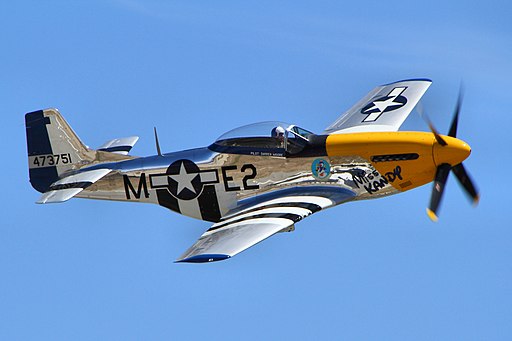Swirling amidst the chronicles of aviation history, the tale of the P-51 Mustang and its heart, the Rolls-Royce Merlin engine, stands out as an embodiment of innovation meeting necessity.
In the turbulent skies of World War II, many aircraft soared, battled, and bled, but none could boast the majestic synthesis of design and power quite like the P-51 Mustang. Its metamorphosis from a promising yet limited airframe into one of the war’s most formidable fighters is a testament to the magic of the Merlin – Rolls-Royce’s revolutionary engine.
Humble Beginnings
When the Mustang first graced the skies in 1940, it carried with it an Allison V-1710 engine. And while this engine was commendable at lower altitudes, its performance began to taper off sharply as it climbed. Given the high-altitude aerial duels that often characterized WWII dogfights, this was a significant shortfall.
The Meeting of Titans
It wasn’t until a fateful collaboration between British and American engineers that the Mustang’s destiny shifted. They hypothesized: What would happen if the P-51, with its already stellar aerodynamics, married the raw high-altitude prowess of the Rolls-Royce Merlin engine?
Thus, the Packard V-1650 Merlin was born – an American-made version of the Rolls-Royce powerhouse. It was like the stars aligned just for aviation.
Unleashing the Beast
Incorporating the Merlin into the Mustang was more than just a simple engine swap. This was the blending of British engineering finesse with American industrial might. The resulting P-51B and subsequent models showcased an astonishing increase in performance. The Mustang could now accompany bombers to the heart of Nazi Germany and back, proving instrumental in the Allies’ daylight bombing campaign.
With the Merlin’s supercharger singing its tune, the P-51 could maintain peak performance at much higher altitudes, often having the edge over its German counterparts. The Luftwaffe pilots, once kings of the European skies, found themselves contending with a rejuvenated adversary that wasn’t just their equal but often their superior.
Beyond Raw Power
Yet the magic of the Merlin wasn’t confined to mere thrust. It brought with it enhanced fuel efficiency – an oft-underestimated trait in aerial combat. With its laminar flow wing and the Merlin’s efficiency, the Mustang could embark on more extended missions, becoming the protector of Allied bombers – a guardian angel with a bite.
Legacy of the Merlin Magic
The transformative impact of the Merlin engine on the P-51 Mustang is an enduring testament to how critical components can define the fate of entire systems. It’s a reminder that sometimes, the sum of parts can lead to a holistic evolution, elevating something good to legendary status.
In the dance of engineering and warfare, the P-51 and Merlin engines waltzed together in a harmony that changed the course of history. In their legacy, we find an ode to innovation, resilience, and the sheer magic that can emerge when vision meets necessity.
For more insights into the P-51 & F-16 and other important military aircraft, visit Aces In Action. Here, you’ll find an amazing piece of artwork by Craig Tinder titled “American Evolution,” which illustrates the evolution of 30 years between two of America’s front-line air superiority fighters – the P-51 Mustang and the F-16 Fighting Falcon. The limited edition canvas print even includes a fragment from a fuselage panel of a P-51 and a piece from an F-16 access door.
American Evolution – P-51 & F-16 Aviation Art by Craig Tinder
A tribute to American air power, American Evolution displays two iconic American fighters – the P-51 Mustang and F-16 Fighting Falcon in a display of U.S. air superiority. With just over 30 years of evolution between these aircraft, they served over 25 various countries as front-line fighter aircraft. The P-51 Mustang and F-16 Fighting Falcon can still be seen together at various airshows across the United States.






Share:
Defensive Arsenal: The B-17’s Gun Turrets
Anatomy of a Dogfight: Did a Spitfire shoot down an Me 262?